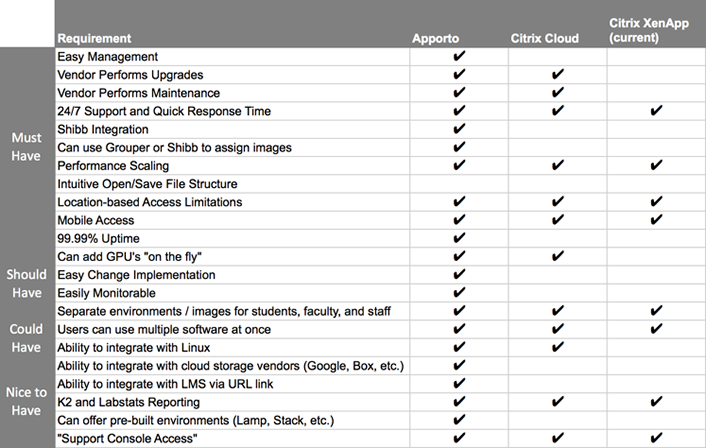NYU was an early adopter of virtualization and implemented an on-prem virtual lab solution back in 2010. Looking to improve service and cut costs, the university conducted an extensive vendor evaluation and opted for a next-gen cloud solution.
About NYU

NYU's student body numbers more than 59,000 students and spans every habitable continent. Situated in some of the most expensive real estate in the world, the university carefully considers use of physical space. As such, NYU was an early adopter of virtualization, implementing a Citrix-based solution back in 2010.
Challenges
Virtual computer lab (VCL) utilization at NYU has grown 20–30% in the past few years. Yet complexity, cost, and quality have been ongoing issues with the existing on-prem solution:
Poor Student Experience
The on-prem solution required students to download and install a receiver, which can be problematic on some computers. Further, the students needed to use VPN to access the university network. Finally, the remote sessions would sometimes crash unexpectedly. This resulted in numerous support requests and dissatisfied users.
Lots of Moving Parts
With 20 servers and counting (app servers, license servers, storefront servers, provisioning servers, and more), there were a lot of moving parts. Additional complexity came from implementing redundant servers, app server images, and a development environment. The NYU IT team had to spend significant time maintaining the infrastructure.
Big Gaps in Functionality
NYU's Citrix-based solution had several limitations. It was not SSO enabled and could not isolate end-user groups (i.e., specific classes, faculty, staff, etc.). Performance was limited and therefore made it impossible to provide resource-intensive research software to students. Additionally, the system was vulnerable—a single user could crash the system, creating problems for other students.
Upgrading Is a Pain
Upgrading Citrix was challenging. Upgrades were staff-intensive and required additional services. Configuration for hardware and firewall rules took several months. Lastly, licensing models based on on-prem hardware did not fit the university's needs.
Expensive Just to Keep the Lights On
With a complex infrastructure, maintenance, and staff, consulting costs remained high—not to mention an expensive annual license fee. Just keeping the lights on was an expensive prospect.
The Search for a Solution
Faced with an infrastructure approaching end-of-life and the prospect of a costly upgrade, NYU kicked off the process by gathering requirements from all stakeholders. The requirements were then placed under four rubrics: (1) Must Have, (2) Should Have, (3) Could Have, and (4) Nice to Have. Download [http://www.apporto.com/download/NYU_case_study_resources] the matrix of technical requirements created by NYU.
In addition to the technical requirements, NYU decided to run a pilot and proactively seek feedback from the user community. Further, the university incentivized students to provide feedback by entering respondents into a raffle to win an iPad. Download [http://www.apporto.com/download/NYU_case_study_resources] the feedback form used by NYU to solicit feedback from students.
Pilot Process
First, NYU ran a proof of concept that determined that Apporto could meet its technical requirements. Then the university ran a four-month pilot during which students were offered the option to use the existing on-prem solution or Apporto. Students were then asked to compare their experiences by filling in the survey form. Further, NYU IT kept track of the "stickiness" of Apporto by keeping track of the number of the students who used Apporto but went back to using the old on-prem solution.
The user surveys were strongly in favor of the Apporto service. For instance, three-quarters of students preferred Apporto to the current on-prem solution, citing ease of use and sturdiness (see figure below).

NYU IT compiled a matrix that showed how various vendors compared in terms of meeting the list of technical specs.

Finally, NYU IT ran a cost analysis comparing the costs of maintaining the existing solution or moving to Apporto. The cost of the Apporto service was less than half the cost of maintaining the existing solution, while providing superior functionality. Download [http://www.apporto.com/download/NYU_case_study_resources] the details of the NYU cost analysis.
Conclusion
A Clear Winner
Typically, NYU sees a 20–30% increase in utilization year-over-year. In the first month running Apporto, they saw a three-fold increase in usage (64% YOY increase).
The simplicity of setup and improved performance contribute to student success. Infrastructure simplicity is more sustainable over a global network of sites and campuses with varying degrees of support for students. Pursuing a SaaS solution streamlined and simplified NYU's operational requirements and lowered costs. This, in turn, has contributed toward NYU's drive to affordability for students.
Students faced fewer barriers to access software and experienced better performance—transforming technology from a hassle to an asset. For NYU, Apporto was a definite improvement over their Citrix implementation and substantially lowered costs.
Running in the cloud enabled NYU to scale up to meet peak demand during the fall and spring terms while saving cost during the slower periods. Additionally, GPUs are spun up "on the fly," enabling students to run graphic and compute-intensive applications. For students, the experience is far simpler, eliminating barriers to use. Apporto also met NYU's uptime SLAs, provided 24/7 support, and the company serves as a close partner to NYU, working together to meet NYU's tactical and strategic objectives and collaborating on new features.
Listen [https://www.youtube.com/watch?v=-HIbXcHpyws&t=1110s] to the recording of the NYU webinar and take a look at what the NYU VCL looks like. If you have any questions, drop us an email at [email protected].
Antony Awaida is CEO of Apporto.
© 2018 Apporto.

